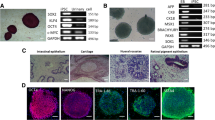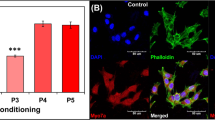Abstract
The high incidence of hearing loss in human combined with the lack of hair cell regeneration in mammalian cochleae had got the attention to manipulate stem/progenitor cells to participate in hair cell regeneration for years. Cochlear progenitor cells are considered as the best candidate for hair cell regeneration. However, there is not any effective and feasible way to separate hair cell progenitors from rat cochleae, yet. In this study, we tried to isolate single epithelial cells from rat basilar membrane by combinatorial enzymatic digestion with thermolysin and collagenase type I. The results showed that the harvested single cells gave rise to otospheres with features of stem cells and could be induced to differentiate into hair cells. Significantly, more otospheres of epithelial origin were obtained by digesting with thermolysin and collagenase type I. The combinatorial enzymatic digestion would be a potential method for hair cell progenitor isolation and culture with broad applications.







Similar content being viewed by others
References
Baten A, Sakamoto K, Shamsuddin AM (1992) Long-term culture of normal human colonic epithelial cells in vitro. FASEB J 6:2726–34
Diensthuber M, Oshima K, Heller S (2009) Stem/progenitor cells derived from the cochlear sensory epithelium give rise to spheres with distinct morphologies and features. J Assoc Res Otolaryngol 10:173–90
Doetzlhofer A, White PM, Johnson JE, Segil N, Groves AK (2004) In vitro growth and differentiation of mammalian sensory hair cell progenitors: a requirement for EGF and periotic mesenchyme. Dev Biol 272:432–47
Doyle KL, Kazda A, Hort Y, McKay SM, Oleskevich S (2007) Differentiation of adult mouse olfactory precursor cells into hair cells in vitro. Stem Cells 25:621–7
Du D, Lou X (2014) Generation of induced pluripotent stem cells from neonatal mouse cochlear cells. Differentiation 87:127–33
Hybbinette S, Bostrom M, Lindberg K (1999) Enzymatic dissociation of keratinocytes from human skin biopsies for in vitro cell propagation. Exp Dermatol 8:30–38
Jeon SJ, Oshima K, Heller S, Edge AS (2007) Bone marrow mesenchymal stem cells are progenitors in vitro for inner ear hair cells. Mol Cell Neurosci 34:59–68
Lendahl U, Zimmerman LB, McKay RD (1990) CNS stem cells express a new class of intermediate filament protein. Cell 60:585–595
Liu Z, Zhang P, Zhou Y, Qin H, Shen T (2010) Culture of human intestinal epithelial cell using the dissociating enzyme thermolysin and endothelin-3. Braz J Med Biol Res 43:451–459
Lou X, Dong Y, Xie J, Wang X, Yang L, Tokuda M, Zhang Y (2014a) Comparing the cultivated cochlear cells derived from neonatal and adult mouse. J Transl Med 12:150
Lou X, Xie J, Wang X, Yang L, Zhang Y (2014b) Comparison of sphere-forming capabilities of the cochlear stem cells derived from apical, middle and basal turns of murine organ of Corti. Neurosci Lett 579:1–6
Maass JC, Berndt FA, Canovas J, Kukuljan M (2013) p27Kip1 knockdown induces proliferation in the organ of Corti in culture after efficient shRNA lentiviral transduction. J Assoc Res Otolaryngol 14:495–508
Oshima K, Grimm CM, Corrales CE, Senn P, Martinez Monedero R, Geleoc GS, Edge A, Holt JR, Heller S (2007) Differential distribution of stem cells in the auditory and vestibular organs of the inner ear. J Assoc Res Otolaryngol 8:18–31
Oshima K, Senn P, Heller S (2009) Isolation of sphere-forming stem cells from the mouse inner ear. Methods Mol Biol 493:141–62
Perreault N, Beaulieu JF (1996) Use of the dissociating enzyme thermolysin to generate viable human normal intestinal epithelial cell cultures. Exp Cell Res 224:354–64
Seach N, Wong K, Hammett M, Boyd RL, Chidgey AP (2012) Purified enzymes improve isolation and characterization of the adult thymic epithelium. J Immunol Methods 385:23–34
Shi F, Hu L, Jacques BE, Mulvaney JF, Dabdoub A, Edge AS (2014) beta-Catenin is required for hair-cell differentiation in the cochlea. J Neurosci 34:6470–9
Shi F, Kempfle JS, Edge AS (2012) Wnt-responsive Lgr5-expressing stem cells are hair cell progenitors in the cochlea. J Neurosci 32:9639–48
Sun C, Zhao J, Jin Y, Hou C, Zong W, Lu T, Li H, Gao J (2014) PTEN regulation of the proliferation and differentiation of auditory progenitors through the PTEN/PI3K/Akt-signaling pathway in mice. Neuroreport 25:177–83
Wang XR, Zhang XM, Du J, Jiang H (2012) MicroRNA-182 regulates otocyst-derived cell differentiation and targets T-box1 gene. Hearing Res 286:55–63
White PM, Doetzlhofer A, Lee YS, Groves AK, Segil N (2006) Mammalian cochlear supporting cells can divide and trans-differentiate into hair cells. Nature 441:984–7
Zhang Y, Zhai SQ, Shou J, Song W, Sun JH, Guo W, Zheng GL, Hu YY, Gao WQ (2007) Isolation, growth and differentiation of hair cell progenitors from the newborn rat cochlear greater epithelial ridge. J Neurosci Meth 164:271–9
Acknowledgments
This work was supported by the National Natural Science Foundation of China (grant no. 81271069) and the National Natural Science Foundation of Major Projects Overseas of China (grant no. 81120108008)
Author information
Authors and Affiliations
Corresponding author
Ethics declarations
All procedures concerning the animals in this study were approved by the Institutional Animal Care and Use Committee of the Fourth Military Medical University and were in compliance with the National Institute of Health Guide for the Care and Use of Laboratory Animals.
Additional information
Editor: Tetsuji Okamoto
Yong-li Song and Ke-yong Tian contributed equally to this work.
Rights and permissions
About this article
Cite this article
Song, Yl., Tian, Ky., Mi, Wj. et al. Combinatorial enzymatic digestion with thermolysin and collagenase type I improved the isolation and culture effects of hair cell progenitors from rat cochleae. In Vitro Cell.Dev.Biol.-Animal 52, 537–544 (2016). https://doi.org/10.1007/s11626-015-9998-4
Received:
Accepted:
Published:
Issue Date:
DOI: https://doi.org/10.1007/s11626-015-9998-4




